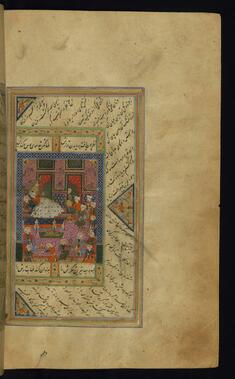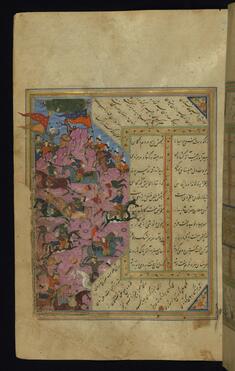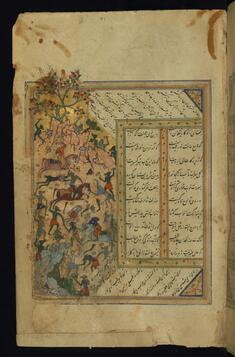Two Poetical Works: Yusuf and Zulaykha and Mihr and Mushtari
(Manuscripts and Rare Books, Islamic World , Islamic Manuscripts)
Walters manuscript W.645, this illuminated and illustrated Safavid manuscript, executed in Safavid Iran in the 10th century AH/AD 16th, contains two poetical works: Yusuf va Zulaykha by Nur al-Din Jami (died 898 AH/AD 1492) and Mihr va Mushtari by Muhammad ibn Ahmad "Assar Tabrizi (died 784 AH/AD 1382). The 2 texts can be read side by side on the same page, either written horizontally or obliquely. There are 4 paintings illustrating the text (fols. 58b, 91a, 159a, and 180b). The brown leather binding with dentelle-style decoration in multi-colored filigree work may date to the 10th century AH/AD 16th, although it is unlikely to be original to the manuscript.
Provenance
Provenance (from the French provenir, 'to come from/forth') is the chronology of the ownership, custody, or location of a historical object. Learn more about provenance at the Walters.
'Abduhu Muhammad Kazim [date and mode of acquisition unknown] [oval seal on fol. 113b]; 'Ismat Zinat Sultan, 1249 AH/AD 1833 (?) [mode of acquisition unknown] [square seal dated 12(?)49 AH/AD 1833 on fol. 114a]; Henry Walters, Baltimore [date and mode of acquisition unknown]; Walters Art Museum, 1931, by bequest.
Geographies
Iran (Place of Origin)
Measurements
Folio H: 10 5/8 x W: 6 11/16 in. (27 x 17 cm)
Credit Line
Acquired by Henry Walters
Location in Museum
Not on view
Accession Number
In libraries, galleries, museums, and archives, an accession number is a unique identifier assigned to each object in the collection.
In libraries, galleries, museums, and archives, an accession number is a unique identifier assigned to each object in the collection.
W.645
Do you have additional information?
Related Objects

Binding from Two Poetical Works: Yusuf and Zulaykha and Mihr and Mushtari

The Wedding Festivities of Yusuf and Zulaykha

Qara Khan, King of Samarqand, Defeated by Mihr





